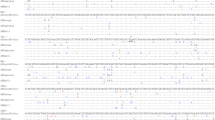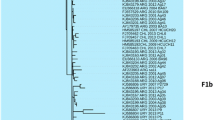Abstract
Hepatitis A virus (HAV) is a hepatotropic member of the family Picornaviridae. Currently, the entire nucleotide sequence is available for only 26 HAV isolates. The complete genome sequence of genotype IA HAV from strains isolated in South America, where genotype IA is the most prevalent genotype, remains unknown. In this study, the complete nucleotide sequence was determined for a genotype IA HAV isolate recovered from a Uruguayan patient (HAV5). Phylogenetic analysis performed using HAV5 and all available full-length IA genotype HAV strains revealed a high synonymous substitution rate throughout the HAV polyprotein. The results of these studies revealed strong selection against amino acid replacements along the HAV polyprotein and may explain, at least in part, the presence of a single HAV serotype.




Similar content being viewed by others
References
Abuzwaida AR, Sidoni M, Yoshida CF, Schatzmayr HG (1987) Seroepidemiology of hepatitis A and B in two urban communities of Rio de Janeiro, Brazil. Rev Inst Med Trop Sao Paulo 29:219–223
Alvarez-Valin JF, Tort JF, Bernardi G (2000) Nonrandom spatial distribution of synonymous substitutions in the GP63 gene from Leishmania. Genetics 155:1683–1692
Ching KZ, Nakano T, Chapman LE, Demby A, Robertson BH (2002) Genetic characterization of wild-type genotype VII hepatitis A virus. J Gen Virol 83:53–60
Cristina J, Costa-Mattioli M (2007) Genetic variability and molecular evolution of Hepatitis A virus. Virus Res 127:151–157
Comeron JM (1995) A method for estimating the number of synonymous and nonsynonymous substitutions per site. J Mol Evol 41:1152–1159
Costa-Mattioli M, Di Napoli A, Ferre V, Billaudel S, Perez-Bercoff R, Cristina J (2003) Genetic variability of hepatitis A virus. J Gen Virol 84:3191–3201
Costa-Mattioli M, Cristina J, Romero H, Perez-Bercoff R, Casane D, Colina R, Garcia L, Vega I, Glikman G, Romanowsky V, Castello A, Nicand E, Gassin M, Billaudel S, Ferre V (2002) Molecular evolution of hepatitis A virus: a new classification based on the complete VP1 protein. J Virol 76:9516–9525
Costa-Mattioli M, Ferre V, Monpoeho S, Garcia L, Colina R, Billaudel S, Vega I, Perez-Bercoff R, Cristina J (2001) Genetic variability of hepatitis A virus in South America reveals heterogenety and co-circulation during epidemic outbreaks. J Gen Virol 82:2647–2652
Cohen JI, Ticehurst JR, Purcell RH, Buckler-White A, Baroudy BM (1987) Complete nucleotide sequence of wild-type hepatitis A virus: comparison with different strains of hepatitis A virus and other picornaviruses. J Virol 61:50–59
Endo K, Takahashi M, Masuko K, Inoue K, Akahane Y, Okamoto H (2007) Full-length sequences of subgenotype IIIA and IIIB hepatitis A virus isolates: characterization of genotype III HAV genomes. Virus Res 126:116–127
Gaspar AM, Vitral CL, Yoshida CF, Schatzmayr HG (1992) Primary isolation of a Brazilian strain of hepatitis A virus (HAF–203) and growth in a primate cell line (FRhK-4). Braz J Med Biol Res 25:697–705
Guindon S, Lethiec F, Duroux P, Gascuel O (2005) PHYML Online––a web server for fast maximum likelihood-based phylogenetic inference. Nucleic Acids Res 33(Web Server issue):W557–W559
Hollinger FB, Emerson SU (2001) Hepatitis A virus. In: Knipe DM, Howley PM, Griffin DE, Martin MA, Lamb RA, Roizman B, Straus SE (eds) Fields virology, vol 1, 4th edn. Lippincott Williams & Wilkins, Philadelphia, pp 799–840
Jukes T, Kantor C (1969) Evolution of protein molecules. Academic Press, New York
Keane TM, Creevey CJ, Pentony MM, Naughton TJ, McInerney JO (2006) Assessment of methods of amino acid matrix selection and their use on empirical data shows that ad hoc assumptions for choice of matrix are not justified. BMC Evol Biol 6:29
Kwok S, Higuchi R (1989) Avoiding false positives with PCR. Nature 339:237–238
Lole KS, Bollinger RC, Parnjape RS, Gadkari D, Kulkarni SS (1999) Full-length human immunodeficiency virus type I genomes from subtype C-infected seroconverters in India, with evidence of intersubtype recombination. J Virol 73:152–160
Lu L, Ching KZ, de Paula VS, Nakano T, Siegl G, Weitz M, Robertson BH (2004) Characterization of the complete genomic sequence of genotype II hepatitis A virus (CF53/Berne isolate). J Gen Virol 85:2943–2952
Martin A, Lemon SM (2006) Hepatitis A virus: from discovery to vaccines. Hepatology 43:S164–S172
Mbayed VA, Sookoian S, Alfonso V, Campos RH (2002) Genetic characterization of hepatitis A virus isolates from Buenos Aires, Argentina. J Med Virol 68:168–174
Najarian R, Caput D, Gee W, Potter SJ, Renard A, Merryweather J, Nest GV, Dina D (1985) Primary structure and gene organization of human hepatitis A virus. Proc Natl Acad Sci USA 82:2627–2631
Pinto RM, Aragones L, Costafreda MI, Ribes E, Bosch A (2007) Codon usage and replicative strategies of hepatitis A virus. Virus Res 127:158–163
Posada D, Crandall KA (2001) Selection the best-fitting model of nucleotide substitution. Syst Biol 50:580–601
Salminen MO, Carr JK, Burke DS, McCutchan FE (1995) Identification of breakpoints in intergenotypic recombinants of HIV type I by bootscanning. AIDS Res Hum Retroviruses 11:1423–1425
Sanchez G, Bosch A, Gomez-Mariano G, Domingo E, Pinto RM (2003) Evidence for quasispecies distributions in the human hepatitis A virus genome. Virology 315:34–42
Sanchez G, Bosch A, Pinto RM (2003) Genome variability and capsid structural constraints of hepatitis A virus. J Virol 77:452–459
Simmonds P (2006) Recombination and selection in the evolution of Picornaviruses and other mammalian positive-stranded RNA viruses. J Virol 80:11124–11140
Stapleton JT, Lemon SM (1987) Neutralization escape mutants define a dominant immunogenic neutralization site on hepatitis A virus. J Virol 61:491–498
Stene-Johansen K, Jonassent TO, Skaug K (2005) Characterization and genetic variability of hepatitis A virus genotype IIIA. J Gen Virol 86:2739–2745
Thompson JD, Higgins DG, Gibson TJ (1994) CLUSTAL W: improving the sensitivity of progressive multiple sequence alignment through sequence weighting, position-specific gap penalties and weight matrix choice. Nucleic Acid Res 22:4673–4680
Wimmer E, Murdin A (1991) Hepatitis A and the molecular biology of picornaviruses: a case for a new genus of the family Picornaviridae. In: Hollinger FB, Lemon SM, Margolis HS (eds) Viral hepatitis and liver disease. Williams & Wilkins, Baltimore, pp 1–41
Acknowledgments
Authors would like to thank Dr. Mauro Costa-Mattioli, McGill University, Montreal, Canada for invaluable help. We would like to thank Dr. Didier Casane from Laboratoire Evolution Génomes et Spéciation (UPR9034), CNRS, France and Dr. Fernando Álvarez-Valin, Sección Biomatemáticas, Instituto de Biología, Facultad de Ciencias, Uruguay, for invaluable help and critical reading of this work. We would like to thank M.Sc. Pilar Moreno and Lic. Gonzalo Moratorio, from Laboratorio de Virología Molecular, CIN, Facultad de Ciencias. We would like to thank Dr. Rodolfo Vazquez and R.N. Zoraida Fort, from Ministry of Public Health, Uruguay, for their support in sample collections. JC acknowledges support by PEDECIBA (Uruguay). The authors would like to thank the anonymous reviewers for important suggestions regarding this work.
Author information
Authors and Affiliations
Corresponding author
Additional information
Nucleotide sequence data reported are available in the EMBL database under accession number EU131373.
Electronic supplementary material
Below is the link to the electronic supplementary material.
Rights and permissions
About this article
Cite this article
García-Aguirre, L., Cristina, J. Analysis of the full-length genome of hepatitis A virus isolated in South America: heterogeneity and evolutionary constraints. Arch Virol 153, 1473–1478 (2008). https://doi.org/10.1007/s00705-008-0151-5
Received:
Accepted:
Published:
Issue Date:
DOI: https://doi.org/10.1007/s00705-008-0151-5




